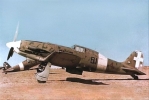
Macchi C.202 Folgore1586 viewswas a World War II fighter aircraft built by Macchi Aeronautica and operated by the Regia Aeronautica (RA; Royal (Italian) Air Force). Macchi aircraft designed by Mario Castoldi received the "C" letter in their model designation, hence the Folgore is referred to as the MC.202. Considered one of the most beautiful fighters to fly with wartime Axis forces, the C.202 was a development of the earlier C.200 Saetta, with a more powerful German Daimler-Benz DB 601 engine and with an extremely streamlined fuselage.[1] Undoubtedly the best wartime fighter to serve in large numbers with the Regia Aeronautica,[2] the Folgore operated on all fronts.[3]
The Folgore went into service with the Regia Aeronautica in July 1941 and immediately proved to be an effective and deadly dogfighter.[4][5] The Australian ace Clive Caldwell, who fought a wide variety of German, Italian and Japanese fighters during 1941–45, later stated that the C.202 was "one of the best and most undervalued of fighters".Jan 12, 2011
|
|
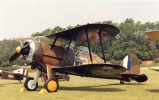
Gloster Gladiator1189 viewsThe Gloster Gladiator (or Gloster SS.37) was a British-built biplane fighter. It was used by the Royal Air Force (RAF) and the Royal Navy (as the Sea Gladiator variant) and was exported to a number of other air forces during the late 1930s. It was the RAF's last biplane fighter aircraft and was rendered obsolete by newer monoplane designs even as it was being introduced. Though often pitted against more formidable foes during the early days of the Second World War, it acquitted itself reasonably well in combat.
The Gladiator saw action in almost all theatres during the Second World War, with a large number of air forces, some of them on the Axis side. The RAF used it in France, Norway, Greece, the defence of Malta, and the brief Anglo-Iraqi War (in which the Royal Iraqi Air Force was similarly equipped). Other countries deploying the Gladiator included China against Japan, beginning in 1938; Finland (along with Swedish volunteers) in the Winter War and the Continuation War; and Norway, Belgium, and GreeceJan 12, 2011
|
|
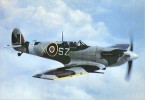
Supermarine Spitfire Mk Vb1092 viewsThe Mk V was produced in greater numbers than any other single mark of Spitfire. It was the main version of the fighter during 1941, replacing the Mk I and II in service in time to take part in the first British counterattacks over France. During the summer of 1941 it held an advantage over the Bf 109, but in September 1941 the Fw 190 made its operation debut, and the Mk V found itself outclassed. Despite this, it remained the main RAF fighter until the summer of 1942, and the low level LF.Mk V remained in use into 1944.Jan 10, 2011
|
|
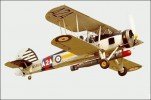
Fairey Albacore1155 viewsThe Fairey Albacore is a single-engine carrier-borne biplane torpedo bomber built by Fairey Aviation between 1939 and 1943 for the Fleet Air Arm. It had a three-man crew and was designed for spotting and reconnaissance as well as delivering bombs and torpedoes. The Albacore, popularly known as the "Applecore", was conceived as a replacement for the ageing Fairey Swordfish, which had entered service in 1936. However, the Albacore served with the Swordfish and was retired before it, being replaced by the monoplane Fairey Barracuda torpedo bomber.
The Albacore prototypes were built to meet Specification S.41/36 for a three-seat TSR (torpedo/spotter/reconnaissance) for the FAA. The first of two prototypes flew on December 12 1938 and production of the first batch of 98 aircraft began in 1939. Early Albacores were fitted with the Bristol Taurus II engine and those built later received the more powerful Taurus XII.
No. 826 Squadron FAA was specially formed to operate the first Albacores in March, 1940. Carrier-based squadrons began operating the Albacore in 1941. Eventually there were 15 FAA squadrons equipped with the plane which operated widely in the Mediterranean. Albacores participated in the Battle of Cape Matapan and the fighting at El Alamein as well as supporting the landings at Sicily and Salerno. During the period September 1941 to end of June 1943 No. 828 Squadron FAA, Hal-Far, Malta, operated a squadron of TSR Fairey Albacores under some of the most severe blitz conditions imaginable during the siege of Malta, mainly against Italian shipping and shore targets in Sicily.
In 1943 the Albacore was replaced by the Barracuda. The last Albacore squadron, No. 841, disbanded in late 1943. The Royal Canadian Air Force took over the Albacores and used them during the Normandy invasion.Sep 18, 2006
|
|
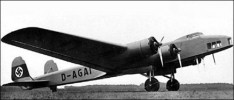
Dornier Do 191252 viewsAlong with the Junkers Ju 89, the Do 19 was developed as part of the "Ural Bomber" program championed by Gen. Walther Wever who forsaw the need for long range strategic bombing capability. When Gen. Wever was killed in April of 1936, the goal of a strategic bombing capability died with him. On April 29, 1937, the Ural-Bomber bomber program was cancelled by Kesselring in spite of protests. Kesselring felt the production and development resources would be better used to develop and build tactical bombers such as the Do 17 and He 111. This philosophy would later haunt and severely handicap the Luftwaffes ability to strike at Russia's production capabilities.Sep 18, 2006
|
|
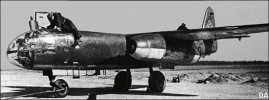
Arado Ar 2401177 viewsThe German Arado 234 was the very first purpose-built jet bomber. While the Ar-234 had very little influence on the outcome of World War II, being much too late and too few in number, it had influence on later aircraft designs. The Ar-234B could be configured either as a bomber or reconnaissance aircraft. It weighed about 5.2 tonnes (11,464 pounds) empty, and about 8.43 tonnes (18,850 pounds) fully loaded. Maximum bomb load was about 1.5 tonnes, carried externally. When used as a reconnaissance aircraft, the AR-234B carried a pair of 300 liter (79 US gallon) drop tanks in place of the bombs.
The powerplants consisted of a pair of Junkers Jumo 004B turbojets, with 900 kilograms (1,980 pounds) thrust each. Maximum speed without bombs or drop tanks was 740 KPH (460 MPH) at 6,100 meters (20,000 feet), but the speed dropped to as low as 660 KPH (410 MPH) with external loads. The prototypes had actually been a good 30 KPH faster than the Ar-234B, due to the more slender fuselage allowed by the lack of landing gear. Tricycle landing gear was fitted. As the Ar-234 landed at high speed, it had a drag chute as standard equipment; it was one of the first aircraft to do so. The rounded nose of the aircraft was covered with plexiglas, giving the pilot an excellent view to the front, but no view to the back except through a periscope. The periscope, which was not provided in the Ar-234 prototypes, also served as a sight for dive-bombing attacks. As a bomber, the Ar-234 was something of a failure. It could not carry enough of a bombload to match the destructive power of the big heavy bombers that were smashing the Reich. However, as a reconnaissance aircraft it proved able to bring back intelligence from airspace denied to prop-driven aircraft.
There were also a number of innovations in the Ar-234 that would be seen in later aircraft. Sep 18, 2006
|
|
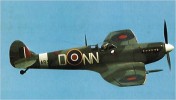
SUPERMARINE SPITFIRE Mk Vc581 viewsPossibly the most famous of all fighters, this particular aeroplane was re-activated to take part in the film "Battle of Britain" in which it flew nearly 50 hours. Now flying reularly at the Shuttleworth Collection.Dec 20, 2004
|
|
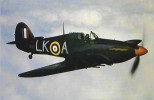
HAWKER HURRICANE Mk IIC615 viewsThis most famous partner to the Spitfire was the predominant fighter in use by the RAF during the Battle of Britain. Designed by Sidney Camm, this aircraft was the first RAF fighter to exceed 300mph & the first eight gun monoplane to enter service. This aircraft saw service throughout the war & was the mount of many great pilots of the War years. It is an interesting & judicious point to note that there were 1,326 Hurricanes & 967 Spitfires on strength during the Battle of Britain, a fine testimony to this fine aeroplane, This particular aircraft was flown by Sqn. Ldr. D. G. Smallwood.Dec 20, 2004
|
|
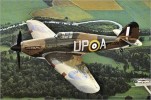
HAWKER HURRICANE Mk IIB511 viewsThe Hurricane bore the brunt of the fighting during the Battle of Britain &, of the 14,00 built, only three examples remain airworthy. This particular machine is painted to represent the aircraft of the late Squadron Leader Archie McKellarDec 20, 2004
|
|
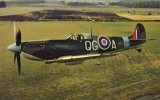
VICKERS ARMSTRONG SUPERMARINE SPITFIRE Mk 1A569 viewsSingle seat fighter powered by a Rolls Royce Merlin II or III liquid cooled in line engine. Maximum speed: 367mph. Armament: eight .303 machine guns. First deliveries to No. 19 Squadron Duxford, June 1938.Dec 19, 2004
|
|
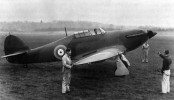
Hurricane MKI552 views The new Mk.I included a deHaviland or Rotol constant-speed metal propeller, ejector exhaust stacks for added thrust, metal-covered wings, armour and other changes. At the start of the war the RAF had taken on about 500 of this later design, and it formed the backbone of the fighter squadrons during the Battle of France and into the Battle of Britain.
Although it may have been an older design, the Hurricane was still a worthy fighter on its own and a reasonable match for the Messerschmitt Bf 109 it faced. In the photo The first production Hurricane Mk.I at [[Brooklands]], November 1937.Dec 19, 2004
|
|
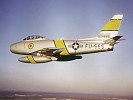
F-86 Sabre523 viewsThe first proposals for the North American Aviation F-86 Sabre were made in 1944, but construction was not begun until after World War II. Many elements of German jet design were implemented in the Sabre. The XP-86 prototype, which would become the F-86 Sabre, flew on 1 October 1947. It often was placed in combat against the superior Soviet MiG-15. Superior US pilot training versus Korean and Chinese training accounted for some of the US success in the air war. Other factors included Soviet pilots' reluctance to engage Americans over battlefields for fear of being captured. Technically, the Soviet Union was not involved in the Korean War, and as such could not afford captured pilots. The Sabre was the first U.S. production aircraft to be fitted with ejector seats. Approximately 9500 were constructed. Several are still held by private owners. Oct 10, 2004
|
|
|
|